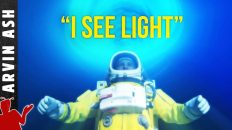Out of body and near death experiences. Are they proof of an afterlife? Out of body, mystical experiences are surprisingly common. Does this mean that life after death exists?
A third of people who have been near death report experiencing such an event. This kind of experience typically involves feelings of peacefulness, out of body detachment, seeing a bright light or moving through a tunnel.
Believers and people of faith say that this is proof of an afterlife, and is evidence of a God that has a plan for our souls upon death. Even scientists say that in order to prove the existence of an afterlife, someone would have to return from the dead to tell us what happened. Doesn’t this near death experience then provide proof of an after life? Or can this phenomenon be explained through testing and science?
First, people’s near death experience seems to be almost universally positive, with people reporting feelings of peace, comfort and reduced anxiety. Second, culture seems to influence what people experience.
A recent scientific study by Neuroscientists Blanke, Faivre and Dieguez concluded that the “disembodied” experience is due to disturbances in a part of the brain called the temporo-parietal cortex. This is the part of the brain that gives us a sense of self, and body. Electromagnetic stimulation of this area has been demonstrated to produce out of body experiences.
What about the people that see tunnels and a bright light at the end of the tunnel? The late Carl Sagan, famous astrophysicist, suggested that death can produce a kind of “remembrance of birth syndrome.” A feeling of being in a tunnel and seeing a bright light at the end of the tunnel is not unlike what a baby might experience as it is being born. And perhaps death can create this connection with latent memories of ones birth, he argued.
When the human brain is dying, researchers have found that the body releases endorphins. These are the natural “feel good” drugs that the body produces typically in times of intense physical pain or suffering. The body does this naturally to suppress pain. Long distance runners have described this as a “runner’s high” for example.
Researchers theorize that when someone is dying, it is these same endorphins that produce a sensation of peacefulness and contentment, not unlike what the people who have undergone near death experiences actually report.
When a dying person is in the hospital, and is under anesthesia, this can also produce feelings of being out of the body. Anesthetics such as ketamine can do this – and people under this anesthetic have reported having near-death type of experiences. But it is in fact just a side effect of this drug. That’s why this is a common club drug.
According to a study by Rick Strassman, a professor of psychiatry at University of New Mexico, which was done from 1990 to 1995, he found that people had near-death and mystical experiences following injection of N, N-dimethyltryptamine or DMT.
DMT is a powerful psychedelic drug that is also known as the “spirt” molecule. Strassman’s study showed that more than half the people injected with this drug had religious experiences, typically interacting with non-human beings in a disembodied state. Strassman says that at near death, the body produces natural DMT in the pineal gland. This is yet another reason that people can have out of body experiences at death.
Scientific explanations of near-death experiences can show how ischemia or lack of oxygen to the brain can result in a state of feeling depersonalization, where the mind can feel that it is separate from the body.
This may be a way that our brains deal with pain during death or high stress. By making the body as not one’s own, one may not feel the physical pain that the body is going through. So this can manifest as a feeling of not being able to identify your body as being “you.” – a feeling of disembodiment can result.
The most widespread explanation for near-death experiences is the dying brain hypothesis. This theory proposes that as cells in the brain begin to die, they start firing randomly, kind of like a last gasp. This can cause hallucinations which manifest as near-death experiences. Under extreme stress, or crisis, brain cells can die, which would explain some of the stories that survivors of severe crisis do actually report.
Some scientists argue that these scientific explanations don’t explain the full range of experiences that people have, so they say that we cannot conclude that all out of body experiences have a scientific explanation.
Since the human brain has 100 billion cells with over 1000 trillion connections, no two people probably have the exact same experience. But there is enough science and enough research to explain how something very similar, even if it is not exact, can happen.







